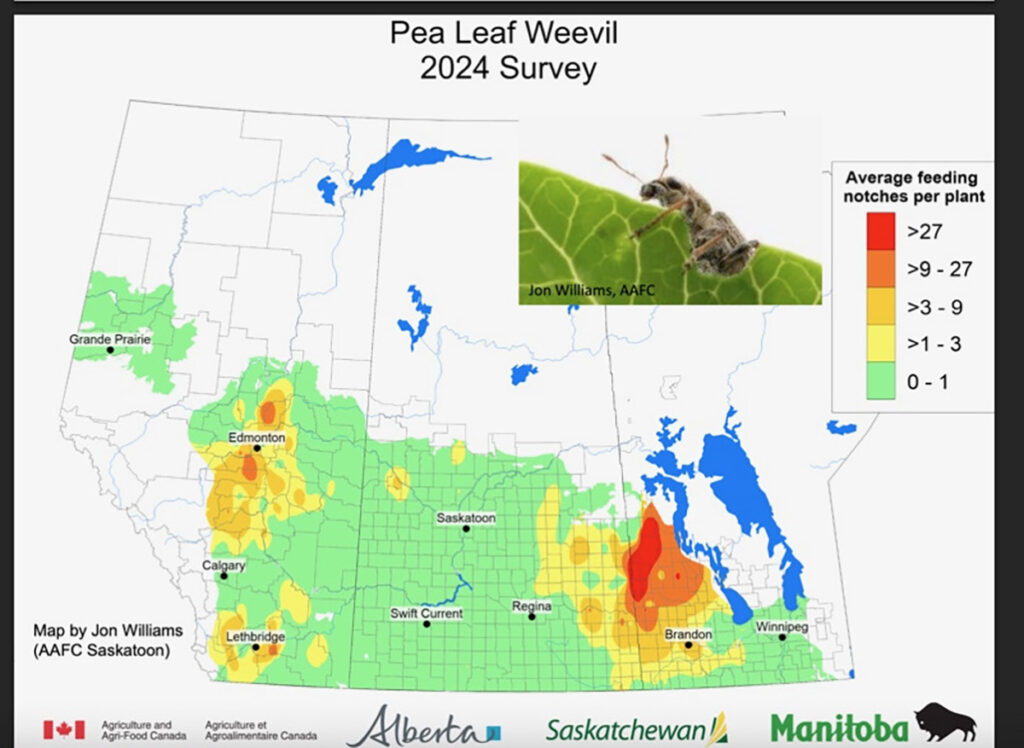Conditions right for pea leaf weevils to thrive

WINNIPEG — Pea leaf weevils were a challenging pest for pea growers near the Manitoba-Saskatchewan border in 2024.
Since adult weevils hide in shelterbelts and under the snow to survive the winter, it’s likely that 2025 will be another difficult year in western Manitoba and eastern Saskatchewan.
“Unless something drastic happens, like a major change in precipitation, the chances are good that areas with high weevil densities last year could have high densities again this year,” said Meghan Vankosky, an entomologist with Agriculture Canada in Saskatoon.
Vankosky is also co-chair of the Prairie Pest Monitoring Network, an insect surveillance program for agricultural pests.
A distribution map on Prairiepest.ca shows that the concentration of pea leaf weevils was highest in 2023 and 2024 in Manitoba’s Parkland region and in east-central Saskatchewan.

In 2023, weevil numbers were also high in regions around Edmonton and Lloydminster.
Many insects cause damage to agricultural crops by feeding on the leaves, but pea leaf weevils are a bit different.
The adults overwinter in alfalfa and other perennial legumes, roadside ditches and shelterbelts, says a North Dakota State University website.
They emerge in the spring, when temperatures are warmer than 15 C, and begin feeding on newly planted field peas or fababeans.
The females lay eggs, and the larvae from those eggs will burrow into the soil, to feed on the roots of pea plants.
“The most critical damage in peas and fababeans comes from the larvae feeding within the root nodules, thereby reducing nitrogen fixation by the crop,” says Saskpulse.com
The weevil larvae consume the bacteria that live inside root nodules, Vankosky said.
“They are actually eating the bacteria…. We think their primary source of nutrition are these nitrogen-fixing bacteria.”
It’s obvious from the distribution map that pea leaf weevils were the most problematic in western Manitoba and eastern Saskatchewan in 2024.
The “why” part is likely connected to precipitation.
More rain and snow means more weevils.
“Either snow cover in the winter, or areas that are getting fairly consistent precipitation throughout the growing season,” Vankosky said.
“Those are the areas, like western Manitoba and eastern Saskatchewan, where we are currently seeing the largest populations.”
Research done around Swift Current, Sask., demonstrated that populations of pea leaf weevils completely crashed when there was a period of dry weather.
“Between spring of 2017 and spring of 2018, it was really, really dry,” Vankosky said.
“The next year (2018), we had basically no weevils.”
The reason?
It’s possible that the larvae cannot burrow through the soil crust, or they die on the soil surface when the weather is hot and dry.
As noted, the larvae of pea leaf weevils feed on the root nodules of pea and fababean plants.
No insecticide exists to target those larvae snacking on the bacteria inside nodules, so it’s critical to control adult weevils before they mate and lay eggs.
Insecticide coated on pea seeds can limit weevil activity and populations early in the growing season, but in-season spraying of insecticides is less effective.
“None of the research we’ve done … we have never seen a significant benefit of applying a foliar insecticide … in terms of yield protection,” Vankosky said.
One strategy that has potential is trap crops.
The new generation of pea leaf weevils come out in the late summer and are looking for anything green to eat.
In research done in Lacombe, Alta., Vankosky and her team seeded a strip of field peas or fababeans in July so that the strip would attract weevils in late August or September.
The strip of crop “definitely worked to bring the weevils in,” she said in 2023.
So, in theory, a farmer could spray insecticides on the trap crop to control the pests before they over-winter.
Contact robert.arnason@producer.com
Source: producer.com

